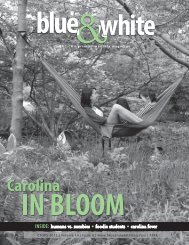then and now - Blue & White Online
then and now - Blue & White Online
then and now - Blue & White Online
You also want an ePaper? Increase the reach of your titles
YUMPU automatically turns print PDFs into web optimized ePapers that Google loves.
There are minorities in Di-Phi, says O’Connor, but therehaven’t been many African-American or Latino members.“Di-Phi, like many other parts of society, has come along way <strong>and</strong> race is not an issue anymore,” he says. “Butback <strong>then</strong>, <strong>and</strong> still to a certain extent today, groups tend toself-segregate.”O’Connor explains that it is hard to attract minorities toa group that does not have many minorities to begin with.“It has a whole ‘boys’ club’ feel, <strong>and</strong> it hasn’t changed indemographics a lot since it started. There’s certainly a lack ofblack people <strong>and</strong> a lack of Hispanics (in Di-Phi).”The club is <strong>now</strong> working to change that reputation. Phamsays she would like for the society to not have the ‘boys’ club’feel or reputation. Meanwhile, O’Connor says that the organizationhas been trying to recruit more minorities.“We want more diversity. We specifically look to get a diversegroup of people, but it’s difficult because we’ll have oneblack person show up to a meeting <strong>and</strong> he’ll come to a fewmore meetings,” O’Connor says. “But in the end, that oneblack guy doesn’t want to be the ‘one black guy (in Di-Phi).’”Di-Phi in the ‘60sDi-Phi’s current faculty advisor, Bl<strong>and</strong> Simpson, is aDi-Phi alumnus. Simpson was in the organization from 1967to 1969, when there were no female members. In fact, therewere only eight full-time members in total, plus two graduatestudents who came to meetings regularly but were notconsidered official members.Women would come to the chambers when the societiesSomeDi-PhiFactsWhy are UNC-CH’s school colors white <strong>and</strong> blue?The Di society color was originally blue (as a symbol of excellence)while the original Phi color was white (as a symbol of truth <strong>and</strong>virtue). The two societies’ senators all wore their society’s colors<strong>and</strong> stood together on football game days as a sign of unity behindthe same team.Can Di-Phi members really not walk on McCorkle Place?Yes, it’s true. All senators must avoid walking on the grass inMcCorkle Place out of respect for Joseph Caldwell, UNC-CH’sfirst president, who is buried here.were debating a particularly interesting topic or hosting aguest speaker. But, in the two years that Simpson was in Di-Phi, not a single woman petitioned to become a member.Simpson says that the organization was certainly notopposed to having women, but most students, both male <strong>and</strong>female, were preoccupied with protesting the Vietnam War.“The idea of getting people into a 19th century lecturehall <strong>and</strong> debating something that was not Vietnam washard,” Simpson says. “They thought what we were doing wasarcane.”He says that the group was noisy, but very friendly, civil<strong>and</strong> accepting, especially toward women.“It would’ve been more fun if there’d been women,”Simpson says.Di-Phi TODAYMore than 40 years later, it’s safe to assume many men inthe organization agree.“It’s the only place on campus where the proportion isn’ta 60/40 (female-to-male ratio),” says current member KeriMajikes, a senior Asian studies <strong>and</strong> peace, war <strong>and</strong> defensemajor from Apex.Female members have come a long way to gain respectin one of the University’s most prestigious clubs. But thatdoesn’t necessarily mean that they want to see a flood of newwomen members anytime soon.“A lot of our members date,” says Pham. “So, the womendo have that sort of advantage.”&Why do UNC-CH library books have inside covers that read “Endowedby the Dialectic <strong>and</strong> Philanthropic Societies”?In 1886, the Di <strong>and</strong> Phi societies each owned over 10,000 books,which they <strong>then</strong> both donated to the library to more than doublethe University’s collection.Are all those fancy paintings real?Yes, Di-Phi has the largest privately owned portrait collection inthe southeastern U.S.Other fun facts:& The Di <strong>and</strong> Phi societies were created through dividing theoriginal Concord society into two societies in 1795.& The Di <strong>and</strong> Phi societies later merged in 1959 to become Di-Phi& Members of the societies call each other senators.& Di-Phi has had a h<strong>and</strong> in founding all of the followingorganizations, which are still in existence today: the GeneralAlumni Association, the Yackety-Yack yearbook, the HonorSystem <strong>and</strong> even (in 1922) the Daily Tar Heel.all facts taken from www.unc.edu/di_phi12 September 2011



